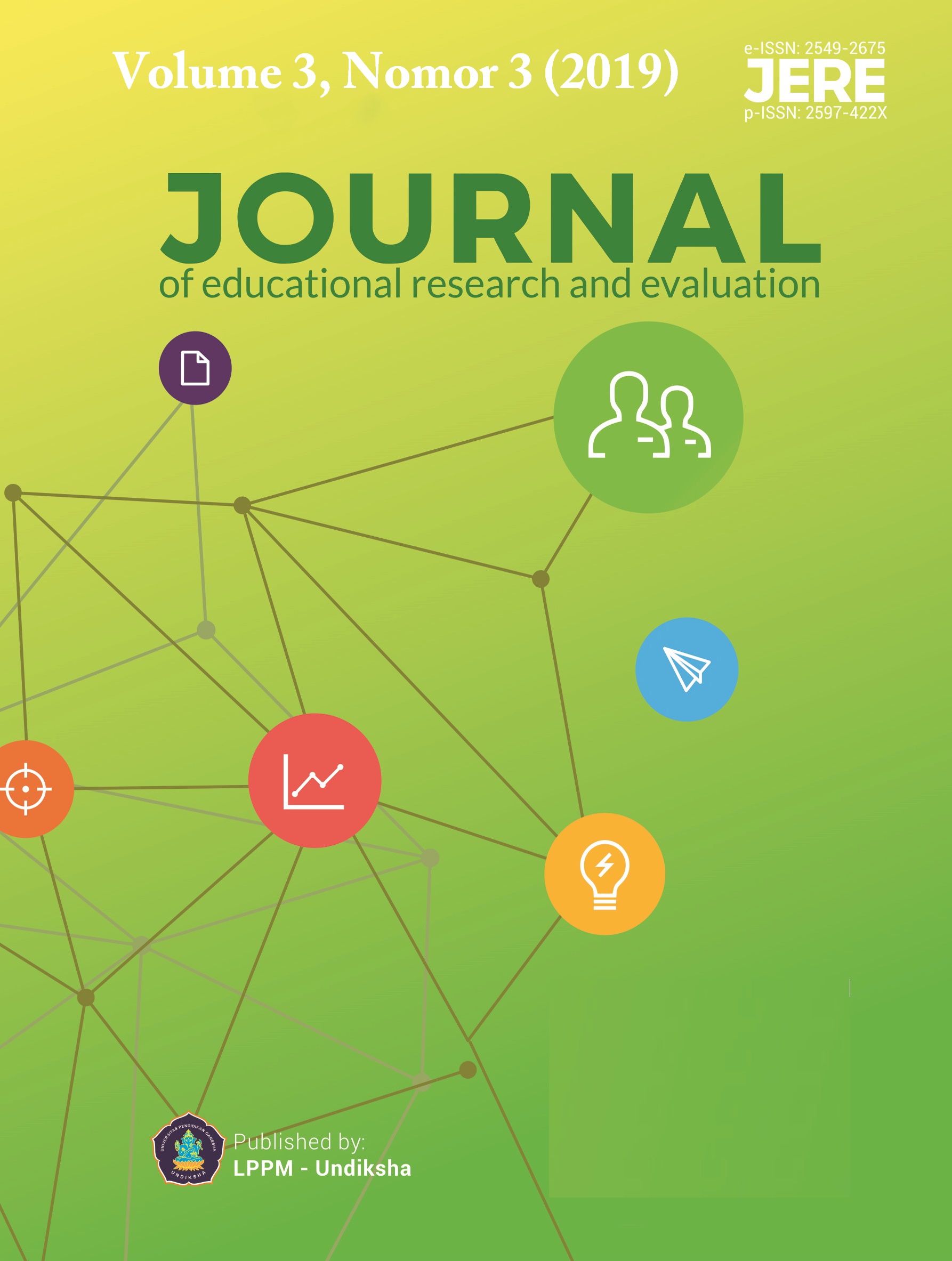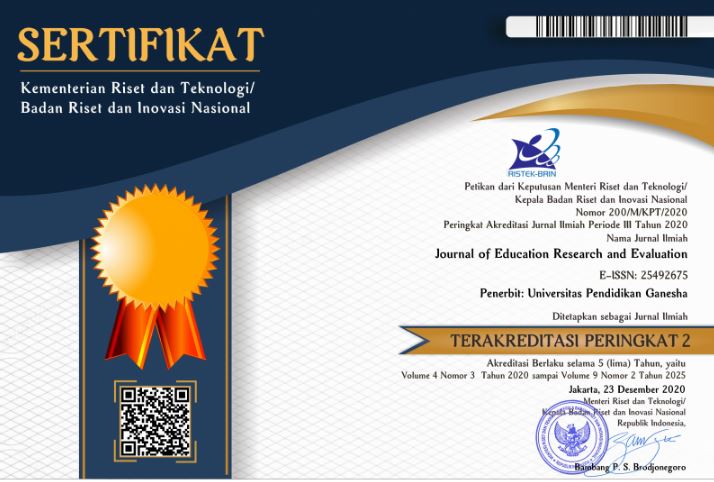The Reflection of HOTS in EFL Teachers’ Summative Assessment
DOI:
https://doi.org/10.23887/jere.v3i3.21853Keywords:
Analysis, Summative Assessment, Revised Bloom's Taxonomy, Higher Order Thinking SkillsAbstract
This study is aimed at analyzing how summative assessments made by eleventh-grade English teachers reflect Higher Order Thinking Skills (HOTS). This was qualitative research that involved 3 English subject teachers in Senior High Schools in Bali, Indonesia. Meanwhile, the object of this research was summative assessment in the form of teacher-made test items for class XI Semester I in the academic year of 2018/2019. The items were analyzed by the document analysis method to determine the extent to which HOTS based on Revised Bloom's Taxonomy was reflected in the teacher-made test. Meanwhile, a one-on-one interview was conducted to obtain data on teacher knowledge about HOTS. The results of this study found that the percentage of HOTS-based teacher-made test items was 5.4% and was still limited to the cognitive level of Analyze (C4). From the results of the analysis, the cognitive levels of students measured were still in Lower Order Thinking Skills (LOTS). This was due to the fact that teachers did not fully understand the concept of Higher Order Thinking Skills. Furthermore, it was obtained from the interview that there was a discrepancy between the knowledge and performance of the teacher in the assessment. Therefore, teachers especially eleventh-grade English teachers have to learn more about HOTS and join training in developing HOTS-based items.
References
Abosalem, Y. (2016). Assessment techniques and students’ higher-order thinking skills. International Journal of Secondary Education, 4(1), 1–11.
Anderson, L. W., Krathwohl, D. R., Airasian, P. W., Cruickshank, K. A., Mayer, R. E., & Pintrich, P. R. (2001). A taxonomy for learning, teaching, and assessing. New York: Pearson Education, Inc.
Brown, H. D. (2003). Language assessment principles and classroom. California: Longman University Press.
Driana, E., & Ernawati. (2019). Teachers’ understanding and practices in assessing higher order thinking skills at primary schools. Acitya: Journal of Teaching & Education, 1(2).
Fanani, M. Z. (2018). Strategi pengembangan soal hots pada kurikulum 2013. Edudeena, 2(1), 57–76.
Marhaeni, A. A. I. N., Dantes, N., & Paramartha, A. A. G. Y. (2018). Teacher assessment literacy : Discrepancies in authentic assessment practice in EFL context. Proceeding Book of 1st International Conference on Educational Assessment and Policy, 2, 18–21.
Mohamed, R., & Lebar, O. (2017). Authentic assessment in assessing higher order thinking skills. International Journal Of Academic Research In Business And Social Sciences, 7(2), 466–476.
Nourdad, N., Masoudi, S., & Rahimali, P. (2018). The effect of higher order thinking skill instruction on efl reading ability. International Journal of Applied Linguistics & English Literature, 7(3), 231–237.
Schulz, H., & FitzPatrick, B. (2016). Teachers’ understandings of critical and higher order thinking and what this means for their teaching and assessments. Alberta Journal of Educational Research, 62(1), 61–86.
States, J. (2018). Summative assessment (wing institute original paper).
Tanujaya, B., Mumu, J., & Margono, G. (2017). The relationship between higher order thinking skills and academic performance of student in mathematics instruction. International Education Studies, 10(11), 78–85.
Thomas, A., & Thorne, G. (2009). How to increase higher order thinking. Center for Development and Learning. Retrieved March 19, 2019, from http://www.cdl.org/resource-library/articles/HOT.php?type=subject&id=18
Widana, I. W. (2017a). Modul penyusunan soal higher order thinking skill (HOTS). Jakarta: Direktorat Pembinaan SMA Ditjen Pendidikan Dasar dan Menengah.
Widana, I. W. (2017b). Higher order thinking skills assessment (HOTS). Journal of Indonesian Student Assessment and Evaluation, 3(1), 32–44.
Widiawati, L., Joyoatmojo, S., & Sudiyanto. (2018). Higher order thinking skills as effect of problem based learning in the 21st century learning. International Journal of Multicultural and Multireligious Understanding, 5(3), 96–105.
Downloads
Published
How to Cite
Issue
Section
License
Authors who publish with the Journal of Evaluation and Research in Education (JERE) agree to the following terms:
- Authors retain copyright and grant the journal the right of first publication with the work simultaneously licensed under a Creative Commons Attribution License (CC BY-SA 4.0) that allows others to share the work with an acknowledgment of the work's authorship and initial publication in this journal.
- Authors are able to enter into separate, additional contractual arrangements for the non-exclusive distribution of the journal's published version of the work (e.g., post it to an institutional repository or publish it in a book), with an acknowledgment of its initial publication in this journal.
- Authors are permitted and encouraged to post their work online (e.g., in institutional repositories or on their website) prior to and during the submission process, as it can lead to productive exchanges, as well as earlier and greater citation of published work. (See The Effect of Open Access)











